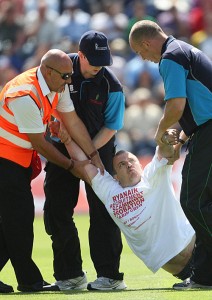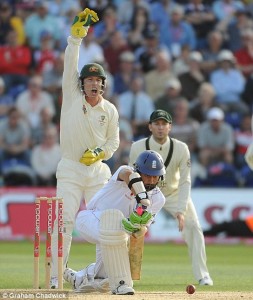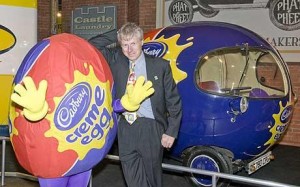
A gradual but inevitable descent into cricket-based loathing and bile.
Classic Series Review: 2009 Ashes
Even with the benefit of hindsight – which, to be fair, is pretty much the whole point of our Classic Series reviews – the 2009 Ashes remain something of an oddity. Everyone remembers the result (spoiler alert: England won!) but the actual details are somewhat hazy. Everyone remembers every single moment of 2005, when two epic teams went head to head, trading blows like Charles Saatchi and Nigella Lawson after a quick trip to the Mayfair branch of Burger King while everyone who isn’t English remembers all the details of 2006/7, when England turned up a shambles and proceeded to get battered, in more ways than one. And 2010/11 is burned onto the collective consciousness as the moment that everyone realised that Australia are now quite shit. But 2009? Time for a trip down memory lane…
First Test, Cardiff
Four years ago, England’s masterplan was to defeat Australia via spin, hence Cardiff serving up a supposed rank turner for the opening game, the first ever Test held in Wales. As plans go, it was a bit of a rubbish one. England picked both Monty Panesar and Graeme Swann, who produced combined match figures of 1/246, the sort of numbers that bring back memories of Ian Salisbury’s glory days. Australia went with just the one full-time spinner, Nathan Hauritz, who did rather better, taking 6/158 across the two innings.

Even at this early stage, it was clear that Nathan Hauritz wasn’t all that enthusiastic about being asked to bowl.
Of course, those numbers don’t tell half the story. England won the toss, chose to bat and made a very solid 435, with every player bar Panesar making it into double figures (but none making it to a hundred). Pietersen made 69, Collingwood 64, Prior 56 and Graeme Swann a lively 47*, being cruelly denied his maiden Test hundred by running out of partners. And, er, not scoring anywhere near enough runs.
A decent score, or so we thought until Australia responded by piling up 674/6 declared, an innings that seemed to last forever. Katich made 122, Ponting 150, North 125* and Haddin 121 as the tourists stockpiled runs like they were going out of fashion. England huffed and puffed (and worked Phil Hughes over with the short ball) but looked about as threatening as Joe Root in a fake beard. Despite our best efforts to drown them with gin, memories began to flood back of 2006/7. It was a dark couple of days.
Inevitably, when England were finally released from their torture in the field, they collapsed with the bat, being 20/2 at the close of the fourth day. On the fifth morning that quickly became 70/5 and the end seemed inevitable.
Enter Paul Collingwood.
(Actually he was already at the crease by this point, having come in at 31/3, but the point still stands).
We spend a lot of our time abusing ginger people, whether on the site or in the street. You can debate whether this policy is correct or not (we’ll just point out that the work experience boy is ginger and move swiftly on) but there’s no doubt that we found it extremely difficult to hurl abuse at Collingwood after his magnum opus innings of 74 from 245 balls, lasting more than four hours. A masterpiece in using his short backlift to block almost everything, it lifted England from facing certain defeat to the heady heights of facing certain defeat, just a bit later in the day.
Enter James Anderson and Monty Panesar.
Quite how Anderson and Panesar batted for 69 and 37 minutes respectively is something of a mystery even now. We’ve seen Monty bat a fair few times and making it through a single over is usually cause for celebration, let alone nearly 12 of the things. And yet survive they did, as Hauritz, Peter Siddle and, er, Marcus North probed away. Nobody dared move from their seat, leaving our gin glasses empty for the first time in the match. And finally, at around 6:40pm, the torture was over. The teams shook hands, Monty punched the air and everyone breathed a enormous sigh of relief.
Second Test, Lord’s
This is where the fun really started. England won the toss and chose to bat once again, to be faced by a legendarily bad spell of bowling by Mitchell Johnson. Mitch’s first 11 overs went for 77 runs as he sprayed the ball all over the shop. It was a career-defining performance, to the extent that we even did an article of charts about it. As a result of Johnson’s profligacy (aided by Peter Siddle too), England raced to 126/0 at lunch and didn’t lose their first wicket until 196 were on the board. From that moment on they rather stumbled, but eventually finished on 425, led by Andrew Strauss’s regal 161 and Cook’s 95.
Australia’s reply was reassuringly hilarious. Phil Hughes was strangled down the leg side, Ponting was caught off his boot and the rest of the side seemed to be utterly determined to get out hooking or pulling; no less than six of the side eventually got out that way. Australia’s dismal effort of 215 left them facing the follow-on. However, England chose not to enforce it, instead preferring to once more tuck into Mitchell Johnson like Samit Patel attacking a Cadbury’s lorry that had foolishly stopped at the mysterious new traffic lights that had appeared outside his house.
England raced to 331 for 6 in just 72 overs, leaving Australia the small matter of 522 to win. It looked unlikely when Katich and Hughes nicked off and then became less likely as Ponting, Hussey and North followed them back to the nearest Walkabout with just 128 on the board. Then came a monster partnership between Michael Clarke and Brad Haddin, adding 185 to take the score to 313/5 at the end of day four.
Could Australia really do it? You have to remember that back then they weren’t laughably bad and the prospect of a world record chase loomed on the horizon, like a mysterious set of traffic lights outside a house in Nottinghamshire. Of course, we needn’t have worried; Haddin fell early the next morning for 80, Clarke eventually followed for 136 and, despite Mitchell Johnson’s best efforts to make up for his bowling, Australia were bowled out for 406. England won by 115 runs and, as part of the contractual obligations surrounding England’s hype machine, Andrew Flintoff was named man of the match for his scores of 4 and 30*.
Third Test, Edgbaston
After the excitement of the first two Tests, this one was a damp squib in every respect. It rained loads and not a great deal happened. Australia ditched Phil Hughes (not for the last time), bringing Shane Watson in to open, where he did a decent job, making 62 and 53. After him though, Australia once again crumbled, reaching only 263 in their first innings, thanks to Jimmy Anderson (5/80) and Graham Onions (4/58) – including thrillingly the wickets of Watson and Hussey with the first two balls of the second morning, resulting in pandemonium in this part of the world unseen since UB40 stopped touring.
England’s reply saw half-centuries for Strauss (69), Bell (53, in for a rather crippled Kevin Pietersen), Flintoff (74) and Broad (55, back when he was a capable batsman rather than a tailender who thinks he’s a capable batsman) and a first innings lead of 113. After a couple of days of rain Australia comfortably batted out the remainder of the game, Michael Clarke making an unbeaten hundred in the process and Marcus North 96. Whatever happened to him?
Fourth Test, Headingley
It’s a measure of how good Stuart Broad’s batting once looked that England decided he could bat at number seven for the fourth Test, as part of a five man attack. If you were to suggest that nowadays you’d be mercilessly beaten, perhaps through the medium of some snooker balls in a sock, but back then it was considered a reasonable option in the absence of Andrew Flintoff, who was probably off filming some shitty reality show or something. It was an option that was to lead to one of the worst beatings England had suffered for quite some time.
Winning the toss and choosing to bat, the home side were bowled out for just 102 in 34 overs on the first day, comfortably their worst batting performance since the one that gave this site its achingly cool name. Peter Siddle (5/21) and Stuart Clark (3/18), in for Nathan Hauritz, gorged themselves in ideal conditions, like Samit Patel eating the evidence of a successful truck raid. Even before the first tea interval England were utterly screwed.
The rest of the game played out with all the inevitability of a long term Eastenders storyline. Australia racked up 445, Marcus North making another hundred, before blitzing through England in a marginally better 62 overs. It was only some lower order biffing from messers Broad (61) and Swann (62) that took England to the heady heights of 263 and a loss by an innings and 80 runs shortly after lunch on day three.

On the plus side, it did give the players two days to enjoy the very best that Yorkshire had to offer.
It was a defeat that had a huge impact on England: never again after this series would they be bold enough to go with Matt Prior at six and five genuine bowlers. From here on it would be seven batsmen and four bowlers for ever more. They did briefly have Samit Patel at seven, but that was more to do with a secret agreement with Cadbury’s to allow stock to get through the Nottingham area. Plus anyone who considers Samit a genuine Test bowler wants shooting.
Fifth Test, The Oval
It was win or bust for England going into the final Test. In such a situation, changes were called for. Out went Graeme Onions and Ravi Bopara, replaced by Flintoff (making his final Test appearance) and some unknown South African, Jonathan Trott. There was also a return to plan A with an absolute dustbowl pitch. Australia responded by not picking a spinner. Quite why Nathan Hauritz wasn’t included in the side remains something of a mystery to this day: did he really ask not to play? Was he injured after being run over by a Cadbury’s truck exceeding the speed limit in a desperate bid for safety? Or did the Aussie selectors just get it horribly, horribly wrong?
Either way, England won the toss (for the fourth time in the series) and chose to bat. Half centuries from Strauss and Ian Bell took them to 332, not a great score but not a rubbish one either. With the pitch already turning, what could Australia do in response?
The answer was collapse in a spectacular heap.

The bouncy castle served as the perfect metaphor for Australian cricket once Samit had worked his magic.
With Stuart Broad (5/37) actually bowling a full length for once and Graeme Swann (4/38) turning the ball sharply, Australia subsided to just 160 all out. With a lead of 172, it was time to remove the small amounts of food from our fridge and replace them with bottles of champagne. Of course, we had to go down to Tesco to steal the champagne first, but apparently we’re not allowed to talk about that on here.
Of course, this being England, things couldn’t be that simple. Their second innings wobbled alarmingly at the start, stumbling to 39/3 shortly before the close of day two. Luckily this just brought Trott to the crease; he added 118 with Strauss, 11 with Prior, 32 with Flintoff, 43 with Broad, 90 with Swann and 40 with Jimmy Anderson before finally being dismissed for 119. It was one of the great debut innings, as Mark Nicolas probably said at some point.
Australia were faced with the small inconvenience of having to chase down 546 (or bat for more than two days) to win the Ashes. Despite this being incredibly unlikely, there were still some nervous moments: Watson and Katich put on 86 for the first wicket, while Ponting and Hussey took the score to 217/2 before this happened:
From that moment on, England were always in control. Another comedy runout followed shortly afterwards before Marcus North was stumped. Wickets continued to fall, culminating in Hussey being the last man out for 121. Australia were all out for 348, losing by 197 runs.
Unlike 2005’s wild parties, 2009 saw a more restrained celebration. We only got through eight bottles of gin that night, a fairly tame effort by our standards. It was more a feeling of relief than anything else, relief that England hadn’t messed it up at the end.
Conclusion
Even though only four years have passed, 2009 seems a lifetime ago. For a start, Broad and Swann seemed to be quality batsmen back then, contributing 483 runs in the series between them. Plus there was Flintoff, who didn’t actually contribute that much – 200 runs at 33, 8 wickets at 52 and that run out – but still had something of an aura about him, and Harmison, who clearly didn’t.
The statistics for the series are horribly skewed: Australia made eight centuries to England’s two. Indeed, after Strauss (494 runs), England’s second highest scorers, on 261, were Matt Prior and Extras. Thanks Mitchell. No English bowler took 20 wickets, while three Australians did. We love misleading stats.
It’s easy to see this as a turning point for both sides. From here on things would get worse and worse for Australia, leading to the 2010/11 mauling at home and them generally becoming a laughing stock. For England it was the beginning of the golden period under Andy Flower that would see them rise to the top of the Test rankings before, er, going a bit shit again.





1 Comment
Post a Comment
1
Anthony
02 Jul 2013 17:45
Cardiff, day 4, with my Australian girlfriend.
The horror*
*but she’s good with the kids